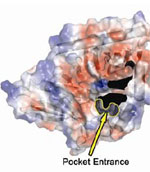Deadly Carcinogen Unraveled: The Molecular Origami of Fungal Polyketides
summary written by Raven Hanna
UC Irvine researchers have unveiled the mystery behind one of the deadliest toxins that causes liver cancer. Aflatoxins are common contaminants of foods such as nuts and grains, which make up the staple diets of many developing countries. These toxins are produced by moldy fungi during food production, and are considered by the FDA to be an unavoidable food contaminant. Aflatoxin molecules are characterized by the presence of multiple aromatic rings. Chronic ingestion of aflatoxin B1 leads to liver tumors that are a major cause of death in Asia, Africa, and Central America. This toxin wreaks havoc of p53, an important gene in our body that prevents cancer. Without the protective effect of p53, then, aflatoxin further compromises immunity, interferes with our body metabolism, and causes severe malnutrition. It is urgently important to find inexpensive strategies that help protect the world population from aflatoxin food contamination.
A group led by researcher Sheryl Tsai of the University of California at Irvine, in collaboration with the Townsend lab of The Johns Hopkins University, used SSRL Beam Line 9-2 to solve two crystal structures of the "product template" (PT) domain that is crucial for aflatoxin formation in the molds. One structure shows a linear substrate analog bound in the active site, while the other shows an intermediate analog. When analyzed in light of the biochemical data, these aflatoxin-PT structures revealed, for the first time, how PT folds an incoming linear carbon chain called a polyketide to form two aflatoxin rings in an amazing feat of origami.
The researchers proposed that understanding how aflatoxin is made will lead to an understanding of how to prevent it and drastically reduce terminal illness in developing countries. The aflatoxin mechanism can also be applied to other moldy toxins. This research is published in the October 22, 2009 issue of Nature.
To learn more about this research see the full Scientific Highlight
Structural basis for biosynthetic programming of fungal aromatic polyketide cyclization. Jason M. Crawford, Tyler P. Korman, Jason W. Labonte, Anna L. Vagstad, Eric A. Hill, Oliver Kamari-Bidkorpeh, Shiou-Chuan Tsai & Craig A. Townsend. Nature 2009, 461, 1139-1143.


